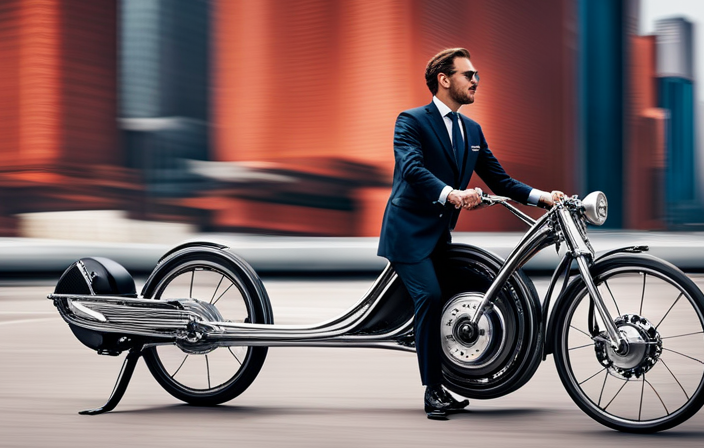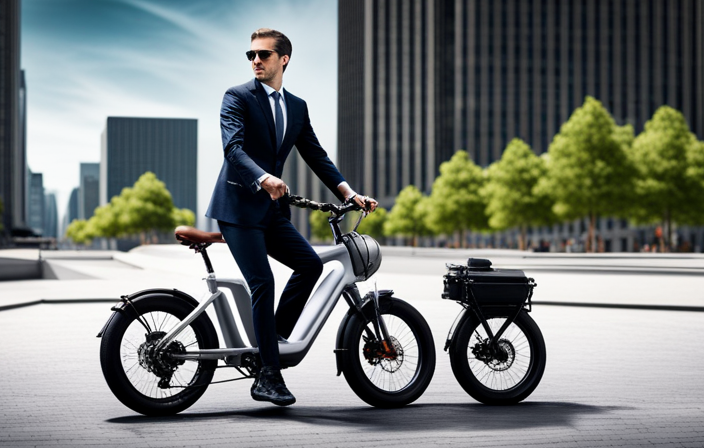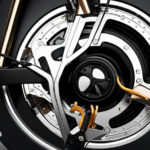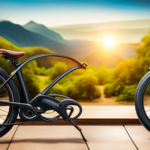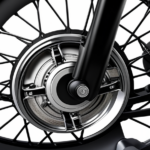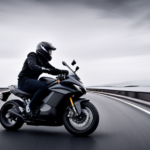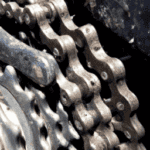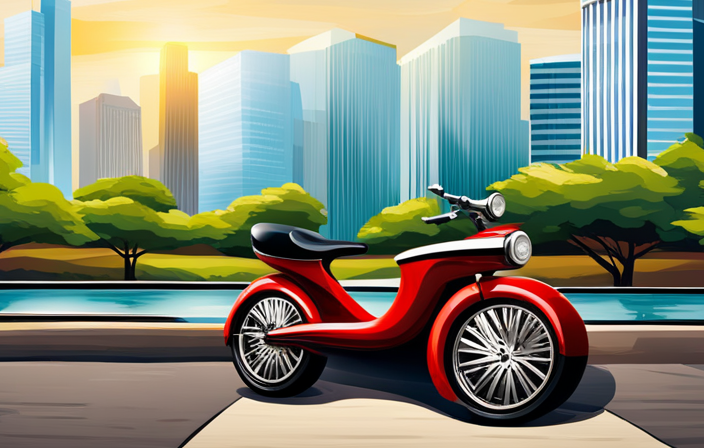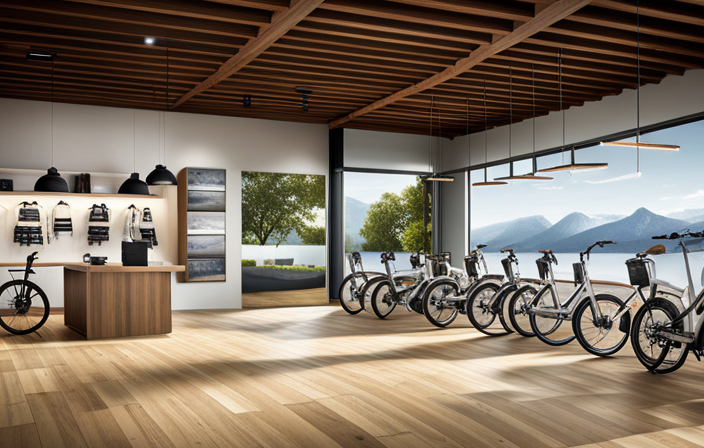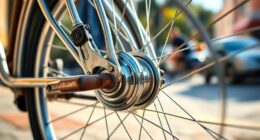Being the proud owner of a month-old electric bike, I couldn’t ignore the mysterious clacking noise coming from my beloved two-wheeler. With a strong determination to solve this puzzling problem, I undertook a comprehensive investigation.
In this article, I will guide you through a step-by-step process of identifying and resolving the source of that bothersome clacking sound. From loose components to damaged spokes, we will leave no stone unturned in our quest to restore tranquility to your electric bike rides.
Key Takeaways
- Loose or damaged cables can cause clacking noises
- Visually inspect cables for fraying or kinks
- Ensure proper seating and secure connections
- Check for cable housing rubbing against frame
Check for Loose Components
You should check if any components are loose on your electric bike to identify the source of the clacking noise. Regular maintenance is important for keeping your bike in good condition and preventing issues like loose components.
There are several common causes of loose components on an electric bike. One possibility is that the bolts securing the handlebars or seatpost may have become loose over time. Another potential cause is loose pedals, which can create a clacking noise when you ride. Loose brake calipers or rotor bolts can also be culprits. It’s important to regularly inspect and tighten these components to ensure a smooth and quiet ride.
Once you have checked for loose components, the next step is to inspect the chain and gears.
Inspect the Chain and Gears
Take a look at the chain and gears to see if there are any issues causing the clacking noise on your electric bike.
Start by checking the battery connection to ensure it’s secure and properly connected. A loose or faulty connection can result in intermittent power delivery, leading to unusual sounds.
Next, inspect the chain for any signs of wear or damage. A worn-out chain can cause the gears to slip, resulting in a clacking noise.
If the chain appears to be in good condition, it may simply need lubrication. Apply a suitable bicycle chain lubricant to ensure smooth movement and reduce friction.
By addressing any issues with the chain and gears, you can eliminate potential causes of the clacking noise and improve the overall performance of your electric bike.
Now, let’s move on to examining the pedals to further troubleshoot the issue.
Examine the Pedals
Now let’s check if there are any issues with the pedals.
The pedals are crucial components of your electric bike, as they provide the power to propel you forward. To ensure they are functioning properly, start by examining the crank arms. These are the connecting rods that attach the pedals to the bike’s drivetrain. Look for any looseness or wobbling, as this could indicate a problem with the pedal’s attachment.
Next, inspect the pedal bearings. These small mechanisms allow the pedals to rotate smoothly. Listen for any grinding or clicking noises, as these might suggest that the bearings need lubrication or replacement.
By thoroughly checking the crank arms and pedal bearings, you can identify and address any potential issues with your electric bike’s pedals.
Now, let’s move on to checking the brakes to complete our inspection.
Check the Brakes
To check the brakes on your electric bike, start by squeezing the brake levers to ensure they engage smoothly and without any resistance.
Proper maintenance techniques are essential to keep your brake system in optimal condition. Regularly inspect the brake pads for wear and replace them if necessary.
Clean the brake rotors with isopropyl alcohol to remove any dirt or debris that may affect braking performance. Additionally, check the brake cables for any signs of fraying or damage, and adjust them if needed.
Common issues with brake systems include squeaking or squealing noises, which can be resolved by cleaning the brake pads and rotors. Another common problem is a soft or spongy brake lever feel, which may indicate air in the brake lines and will require bleeding.
Now, let’s move on to the next section and look for loose or damaged spokes.
Look for Loose or Damaged Spokes
You should check for any loose or damaged spokes on your bike. Loose or damaged spokes can cause a variety of issues, including a clacking noise in your electric bike. Here are three common causes of loose or damaged spokes and signs of wear and tear to look out for:
-
Over-tightening: When spokes are tightened too much, they can become stressed and eventually break. Look for spokes that appear excessively tight or have a strained appearance.
-
Impact damage: Hitting a pothole or curb can put strain on the spokes, causing them to become loose or even break. Check for any visible signs of damage, such as bent or twisted spokes.
-
Fatigue: Over time, spokes can weaken and fatigue, especially if the bike is frequently ridden on rough terrain. Look for signs of corrosion, rust, or fraying at the spoke ends.
Inspecting the spokes is an important step in diagnosing the clacking noise on your electric bike. Once you have checked for loose or damaged spokes, it’s time to inspect the bottom bracket.
Inspect the Bottom Bracket
Take a moment to inspect the bottom bracket of your bike to ensure it’s in good condition. The bottom bracket connects the crankset to the frame of your bicycle.
Start by checking the frame integrity around the bottom bracket area. Look for any cracks or signs of damage, as this could affect the overall stability and performance of your bike.
Next, examine the electrical connections if you have an electric bike. Make sure the wires are securely connected and there are no frayed or damaged cables. A loose or faulty electrical connection can cause issues with the motor or battery.
Now, let’s move on to the next section where we will check the wheel bearings for any potential problems.
Check the Wheel Bearings
Now, let’s move on to checking the wheel bearings for any potential problems. The wheel bearings are crucial components that allow the wheels to rotate smoothly on the axle. Proper lubrication is essential to ensure their longevity and optimal performance. The table below highlights the lubrication requirements for wheel bearings:
| Lubrication Type | Recommended Frequency |
|---|---|
| Grease | Every 3,000 miles |
| Oil | Every 1,000 miles |
| Wax | Every 500 miles |
Failure to lubricate the wheel bearings can lead to premature wear and eventual failure. It’s important to be aware of the common signs of wheel bearing failure, such as excessive noise, vibration, and irregular wheel movement. If you notice any of these signs, it’s crucial to address the issue promptly to avoid further damage and potential safety hazards. After inspecting the wheel bearings, the next area to examine is the handlebars and stem, where we will ensure proper alignment and functionality.
Examine the Handlebars and Stem
To examine the handlebars and stem, make sure they are properly aligned and functioning correctly. Proper handlebar positioning is crucial for a comfortable and efficient riding experience.
Start by ensuring that the handlebars are parallel to the front wheel and aligned with the frame. This will prevent any unnecessary strain on your wrists and arms while riding.
Next, choose the right stem length to suit your body proportions and riding style. The stem connects the handlebars to the bike’s fork, so it’s important that it is the correct length to provide optimal control and stability. By selecting the right stem length, you can achieve a comfortable riding position and improve your overall bike handling.
Now, let’s transition to the next section and inspect the seat and seatpost for any issues.
Inspect the Seat and Seatpost
Make sure that the seat and seatpost are securely fastened and free from any cracks or damage. It is important to have a stable and comfortable seating position when riding your bike.
Start by adjusting the seat height to ensure a proper fit for your body. A seat that is too low can cause discomfort and limit your pedaling efficiency, while a seat that is too high can lead to knee pain and potential injuries.
Additionally, choosing the right seat cushion is crucial for a smooth and enjoyable ride. Look for a cushion that provides adequate support and padding, while also allowing for proper airflow to prevent excessive sweating.
Now, let’s move on to the next section and check the fork and headset for any potential issues.
Check the Fork and Headset
Let’s start by inspecting the fork and headset for any potential issues. The fork and headset are essential components of an electric bike, responsible for steering and stability. Proper maintenance techniques for electric bike forks and headsets can help prevent common issues and ensure a smooth riding experience.
Here are some troubleshooting tips and things to look out for:
- Check for any signs of wear or damage on the fork stanchions and headset bearings.
- Make sure the headset is properly adjusted and tightened.
- Inspect the fork for any oil leaks, which could indicate a problem with the suspension.
- Test the fork and headset by gently rocking the bike back and forth to check for any excessive play or clunking noises.
By properly maintaining your electric bike’s forks and headsets, you can avoid potential issues and ensure a safer and more enjoyable ride.
Now, let’s move on to the next section and look for loose or damaged cables.
Look for Loose or Damaged Cables
Moving on from checking the fork and headset, let’s dive into another possible cause of that clacking noise on your month-old electric bike – loose or damaged cables. Cables play a crucial role in transmitting signals and power between components, ensuring smooth operation. However, if they become loose or damaged, they can create annoying clacking noises.
To troubleshoot this issue, start by visually inspecting all the cables on your electric bike. Look for any signs of fraying, kinks, or loose connections. Ensure that the cables are properly seated in their respective ports and secure any loose connections. Additionally, check if any cable housing is rubbing against the frame or other parts, as this can also lead to clacking noises.
If you identify any damaged cables, it’s important to replace them promptly to prevent further issues. Once you’ve addressed the cable situation, it’s time to move on to the next step – examining the motor and battery.
Examine the Motor and Battery
First, take a close look at the motor and battery on your electric bike. The motor is the heart of your bike’s performance, determining its power and performance. If you notice any unusual sounds or vibrations coming from the motor, it could indicate a problem that needs attention.
Additionally, consider the battery life and range of your electric bike. Make sure the battery is securely attached and free from any damage. Check the battery’s charge level and ensure it is within the recommended range for optimal performance.
As you examine the motor and battery, it’s also a good time to check the tires for any signs of damage or wear. By maintaining these key components, you can maximize the longevity and efficiency of your electric bike.
Check the Tires for Damage or Wear
Take a close look at the tires to check for any signs of damage or wear. Signs of wear on the tires can include uneven tread wear, cracking or bulging sidewalls, and low tread depth. These signs can indicate possible causes of tire damage, such as improper inflation, misalignment, or overloading of the bike. It is important to inspect the tires regularly as they are a crucial component of the bike’s performance and safety. To help you visualize the different signs of wear on the tires, refer to the table below:
| Signs of Wear on Tires | Possible Causes of Tire Damage |
|---|---|
| Uneven tread wear | Improper inflation |
| Cracking or bulging sidewalls | Misalignment |
| Low tread depth | Overloading |
Inspect the Suspension System
To ensure your bike’s optimal performance, checking the suspension system is essential. The suspension plays a crucial role in absorbing shocks and maintaining stability while riding.
If you’re experiencing a clacking noise, it could be an indication of suspension issues. Start by examining the suspension components for any signs of damage, such as cracks or leaks. Ensure that all bolts and fasteners are securely tightened.
If the noise persists, it may be necessary to perform suspension maintenance, such as lubricating the joints and pivots. Additionally, check the suspension settings to ensure they are properly adjusted for your weight and riding style.
Take Your Bike to a Professional for a Tune-Up
After inspecting the suspension system and ensuring its proper functioning, it’s important to take your electric bike to a professional for a tune-up. While regular maintenance can be done at home, a professional tune-up will address any underlying issues that may affect the performance of your bike.
Here are some maintenance tips for electric bikes and common issues that a professional can address:
-
Battery health check: A professional can test the battery’s capacity and ensure it is functioning optimally. They can also provide recommendations for extending its lifespan.
-
Motor performance check: The motor is the heart of an electric bike. A professional can assess its performance, check for any abnormal noises, and make necessary adjustments.
-
Brake inspection: Faulty brakes can be dangerous. A professional can inspect the brake pads, adjust the brake calipers, and ensure smooth and reliable braking.
-
Wheel and tire alignment: Misaligned wheels can affect the handling and efficiency of your electric bike. A professional can align the wheels, check tire pressure, and ensure a smooth ride.
Taking your electric bike to a professional for a tune-up will not only address any issues but also help prolong the lifespan of your bike and ensure a safe and enjoyable riding experience.
Frequently Asked Questions
How often should I check for loose components on my electric bike?
I recommend checking for loose components on your electric bike every few weeks to ensure optimal performance. Regular maintenance is crucial, including cleaning your bike properly and maintaining the tires to prolong their lifespan.
What are the signs of a damaged chain or gears on an electric bike?
Chain maintenance is crucial for electric bikes. Common chain problems include rust, wear, and misalignment. One interesting statistic is that a poorly maintained chain can reduce efficiency by up to 20%. Regular cleaning, lubrication, and proper tensioning can prevent these issues.
How do I inspect the pedals on my electric bike?
To inspect the pedals on your electric bike, start by checking for any loose or damaged parts. Look for signs of wear on the pedal surface and ensure proper lubrication. Troubleshoot any issues by tightening or replacing components as needed.
How often should I check the brakes on my electric bike?
Regular brake maintenance is crucial for optimal performance of an electric bike. Common brake problems include squeaking, rubbing, or lack of stopping power. To fix them, inspect brake pads, adjust calipers, and ensure proper alignment.
What should I look for when examining the motor and battery of my electric bike?
When examining the motor and battery of my electric bike, I start by checking the battery life to ensure it is sufficient for my ride. Then, I troubleshoot any motor issues by inspecting the connections and listening for unusual sounds.
Conclusion
After a thorough inspection of your electric bike, it is crucial to address any clacking noise that may arise.
Loose components, such as pedals or spokes, should be tightened or replaced.
The chain and gears should be well-maintained to ensure smooth performance.
Additionally, the brakes, motor, and battery must be checked for any issues.
Don’t forget to examine the tires for wear and tear, as well as the suspension system.
If you’re unsure about any of these steps, it’s best to consult a professional for a tune-up.
Keep your electric bike in top shape, and enjoy a noise-free ride!
